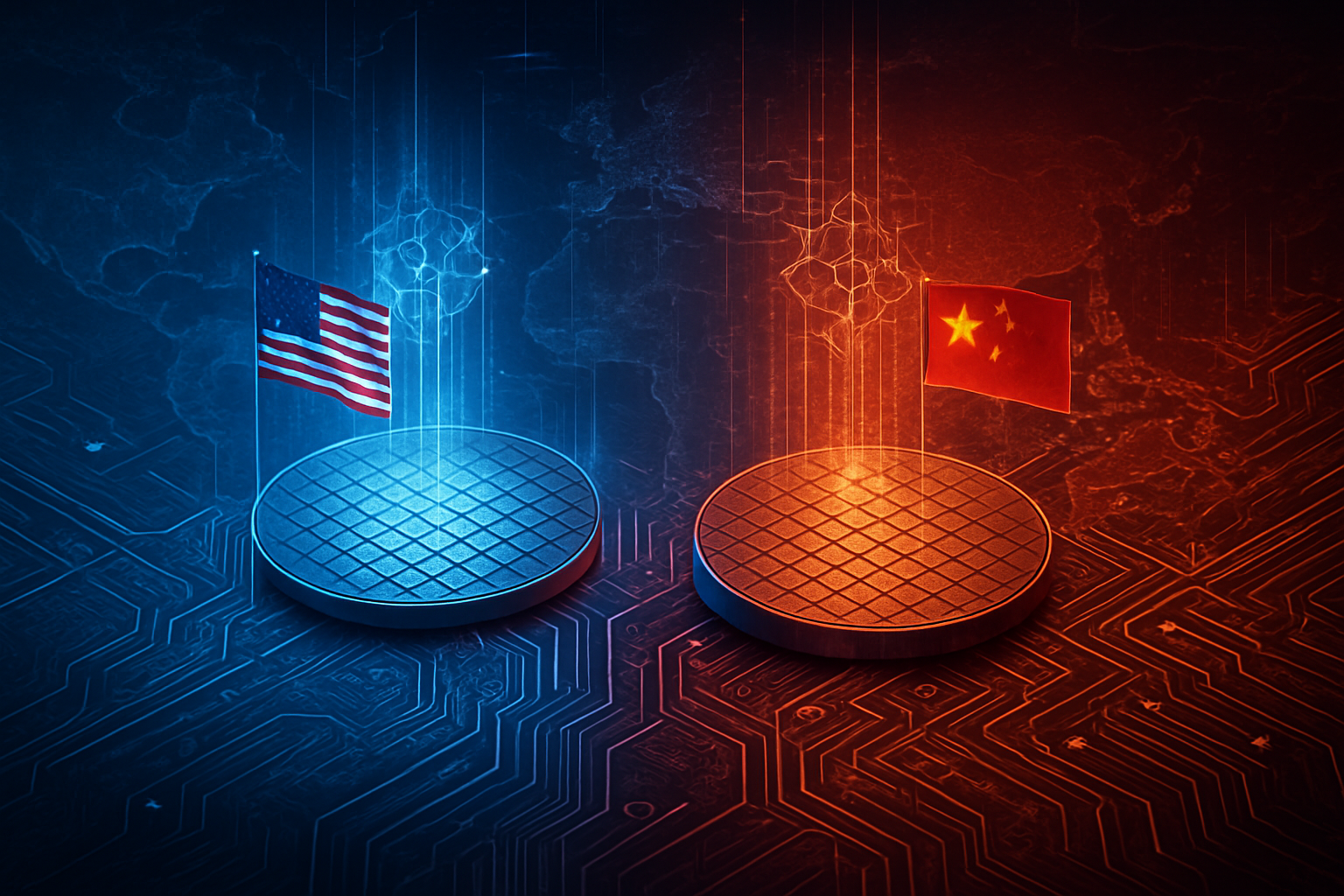The global landscape of chip manufacturing, once primarily driven by economic efficiency and technological innovation, has dramatically transformed into a battleground for national security and technological supremacy. A "Silicon Curtain" is rapidly descending, primarily between the United States and China, fundamentally altering the availability and cost of the advanced AI chips that power the modern world. This geopolitical reorientation is forcing a profound re-evaluation of global supply chains, pushing for strategic resilience over pure cost optimization, and creating a bifurcated future for artificial intelligence development. As nations vie for dominance in AI, control over the foundational hardware – semiconductors – has become the ultimate strategic asset, with far-reaching implications for tech giants, startups, and the very trajectory of global innovation.
The Microchip's Macro Impact: Policies, Performance, and a Fragmented Future
The core of this escalating "chip war" lies in the stringent export controls implemented by the United States, aimed at curbing China's access to cutting-edge AI chips and the sophisticated equipment required to manufacture them. These measures, which intensified around 2022, target specific technical thresholds. For instance, the U.S. Department of Commerce has set performance limits on AI GPUs, leading companies like NVIDIA (NASDAQ: NVDA) to develop "China-compliant" versions, such as the A800 and H20, with intentionally reduced interconnect bandwidths to fall below export restriction criteria. Similarly, AMD (NASDAQ: AMD) has faced limitations on its advanced AI accelerators. More recent regulations, effective January 2025, introduce a global tiered framework for AI chip access, with China, Russia, and Iran classified as Tier 3 nations, effectively barred from receiving advanced AI technology based on a Total Processing Performance (TPP) metric.
Crucially, these restrictions extend to semiconductor manufacturing equipment (SME), particularly Extreme Ultraviolet (EUV) and advanced Deep Ultraviolet (DUV) lithography machines, predominantly supplied by the Dutch firm ASML (NASDAQ: ASML). ASML holds a near-monopoly on EUV technology, which is indispensable for producing chips at 7 nanometers (nm) and smaller, the bedrock of modern AI computing. By leveraging its influence, the U.S. has effectively prevented ASML from selling its most advanced EUV systems to China, thereby freezing China's ability to produce leading-edge semiconductors independently.
China has responded with a dual strategy of retaliatory measures and aggressive investments in domestic self-sufficiency. This includes imposing export controls on critical minerals like gallium and germanium, vital for semiconductor production, and initiating anti-dumping probes. More significantly, Beijing has poured approximately $47.5 billion into its domestic semiconductor sector through initiatives like the "Big Fund 3.0" and the "Made in China 2025" plan. This has spurred remarkable, albeit constrained, progress. Companies like SMIC (HKEX: 0981) have reportedly achieved 7nm process technology using DUV lithography, circumventing EUV restrictions, and Huawei (SHE: 002502) has successfully produced 7nm 5G chips and is ramping up production of its Ascend series AI chips, which some Chinese regulators deem competitive with certain NVIDIA offerings in the domestic market. This dynamic marks a significant departure from previous periods in semiconductor history, where competition was primarily economic. The current conflict is fundamentally driven by national security and the race for AI dominance, with an unprecedented scope of controls directly dictating chip specifications and fostering a deliberate bifurcation of technology ecosystems.
AI's Shifting Sands: Winners, Losers, and Strategic Pivots
The geopolitical turbulence in chip manufacturing is creating a distinct landscape of winners and losers across the AI industry, compelling tech giants and nimble startups alike to reassess their strategic positioning.
Companies like NVIDIA and AMD, while global leaders in AI chip design, are directly disadvantaged by export controls. The necessity of developing downgraded "China-only" chips impacts their revenue streams from a crucial market and diverts valuable R&D resources. NVIDIA, for instance, anticipated a $5.5 billion hit in 2025 due to H20 export restrictions, and its share of China's AI chip market reportedly plummeted from 95% to 50% following the bans. Chinese tech giants and cloud providers, including Huawei, face significant hurdles in accessing the most advanced chips, potentially hindering their ability to deploy cutting-edge AI models at scale. AI startups globally, particularly those operating on tighter budgets, face increased component costs, fragmented supply chains, and intensified competition for limited advanced GPUs.
Conversely, hyperscale cloud providers and tech giants with the capital to invest in in-house chip design are emerging as beneficiaries. Companies like Alphabet (NASDAQ: GOOGL) with its Tensor Processing Units (TPUs), Amazon (NASDAQ: AMZN) with Inferentia, Microsoft (NASDAQ: MSFT) with Azure Maia AI Accelerator, and Meta Platforms (NASDAQ: META) are increasingly developing custom AI chips. This strategy reduces their reliance on external vendors, provides greater control over performance and supply, and offers a significant strategic advantage in an uncertain hardware market. Domestic semiconductor manufacturers and foundries, such as Intel (NASDAQ: INTC), are also benefiting from government incentives like the U.S. CHIPS Act, which aims to re-establish domestic manufacturing leadership. Similarly, Chinese domestic AI chip startups are receiving substantial government funding and benefiting from a protected market, accelerating their efforts to replace foreign technology.
The competitive landscape for major AI labs is shifting dramatically. Strategic reassessment of supply chains, prioritizing resilience and redundancy over pure cost efficiency, is paramount. The rise of in-house chip development by hyperscalers means established chipmakers face a push towards specialization. The geopolitical environment is also fueling an intense global talent war for skilled semiconductor engineers and AI specialists. This fragmentation of ecosystems could lead to a "splinter-chip" world with potentially incompatible standards, stifling global innovation and creating a bifurcation of AI development where advanced hardware access is regionally constrained.
Beyond the Battlefield: Wider Significance and a New AI Era
The geopolitical landscape of chip manufacturing is not merely a trade dispute; it's a fundamental reordering of the global technology ecosystem with profound implications for the broader AI landscape. This "AI Cold War" signifies a departure from an era of open collaboration and economically driven globalization towards one dominated by techno-nationalism and strategic competition.
The most significant impact is the potential for a bifurcated AI world. The drive for technological sovereignty, exemplified by initiatives like the U.S. CHIPS Act and the European Chips Act, risks creating distinct technological ecosystems with parallel supply chains and potentially divergent standards. This "Silicon Curtain" challenges the historically integrated nature of the tech industry, raising concerns about interoperability, efficiency, and the overall pace of global innovation. Reduced cross-border collaboration and a potential fragmentation of AI research along national lines could slow the advancement of AI globally, making AI development more expensive, time-consuming, and potentially less diverse.
This era draws parallels to historical technological arms races, such as the U.S.-Soviet space race during the Cold War. However, the current situation is unique in its explicit weaponization of hardware. Advanced semiconductors are now considered critical strategic assets, underpinning modern military capabilities, intelligence gathering, and defense systems. The dual-use nature of AI chips intensifies scrutiny and controls, making chip access a direct instrument of national power. Unlike previous tech competitions where the focus might have been solely on scientific discovery or software advancements, policy is now directly dictating chip specifications, forcing companies to intentionally cap capabilities for compliance. The extreme concentration of advanced chip manufacturing in a few entities, particularly Taiwan Semiconductor Manufacturing Company (NYSE: TSM), creates unique geopolitical chokepoints, making Taiwan's stability a "silicon shield" and a point of immense global tension.
The Road Ahead: Navigating a Fragmented Future
The future of AI, inextricably linked to the geopolitical landscape of chip manufacturing, promises both unprecedented innovation and formidable challenges. In the near term (1-3 years), intensified strategic competition, particularly between the U.S. and China, will continue to define the environment. U.S. export controls will likely see further refinements and stricter enforcement, while China will double down on its self-sufficiency efforts, accelerating domestic R&D and production. The ongoing construction of new fabs by TSMC in Arizona and Japan, though initially a generation behind leading-edge nodes, represents a critical step towards diversifying advanced manufacturing capabilities outside of Taiwan.
Longer term (3+ years), experts predict a deeply bifurcated global semiconductor market with separate technological ecosystems and standards. This will lead to less efficient, duplicated supply chains that prioritize strategic resilience over pure economic efficiency. The "talent war" for skilled semiconductor and AI engineers will intensify, with geopolitical alignment increasingly dictating market access and operational strategies.
Potential applications and use cases for advanced AI chips will continue to expand across all sectors: powering autonomous systems in transportation and logistics, enabling AI-driven diagnostics and personalized medicine in healthcare, enhancing algorithmic trading and fraud detection in finance, and integrating sophisticated AI into consumer electronics for edge processing. New computing paradigms, such as neuromorphic and quantum computing, are on the horizon, promising to redefine AI's potential and computational efficiency.
However, significant challenges remain. The extreme concentration of advanced chip manufacturing in Taiwan poses an enduring single point of failure. The push for technological decoupling risks fragmenting the global tech ecosystem, leading to increased costs and divergent technical standards. Policy volatility, rising production costs, and the intensifying talent war will continue to demand strategic agility from AI companies. The dual-use nature of AI technologies also necessitates addressing ethical and governance gaps, particularly concerning cybersecurity and data privacy. Experts universally agree that semiconductors are now the currency of global power, much like oil in the 20th century. The innovation cycle around AI chips is only just beginning, with more specialized architectures expected to emerge beyond general-purpose GPUs.
A New Era of AI: Resilience, Redundancy, and Geopolitical Imperatives
The geopolitical landscape of chip manufacturing has irrevocably altered the course of AI development, ushering in an era where technological progress is deeply intertwined with national security and strategic competition. The key takeaway is the definitive end of a truly open and globally integrated AI chip supply chain. We are witnessing the rise of techno-nationalism, driving a global push for supply chain resilience through "friend-shoring" and onshoring, even at the cost of economic efficiency.
This marks a pivotal moment in AI history, moving beyond purely algorithmic breakthroughs to a reality where access to and control over foundational hardware are paramount. The long-term impact will be a more regionalized, potentially more secure, but also likely less efficient and more expensive, foundation for AI. This will necessitate a constant balancing act between fostering domestic innovation, building robust supply chains with allies, and deftly managing complex geopolitical tensions.
In the coming weeks and months, observers should closely watch for further refinements and enforcement of export controls by the U.S., as well as China's reported advancements in domestic chip production. The progress of national chip initiatives, such as the U.S. CHIPS Act and the EU Chips Act, and the operationalization of new fabrication facilities by major foundries like TSMC, will be critical indicators. Any shifts in geopolitical stability in the Taiwan Strait will have immediate and profound implications. Finally, the strategic adaptations of major AI and chip companies, and the emergence of new international cooperation agreements, will reveal the evolving shape of this new, geopolitically charged AI future.
This content is intended for informational purposes only and represents analysis of current AI developments.
TokenRing AI delivers enterprise-grade solutions for multi-agent AI workflow orchestration, AI-powered development tools, and seamless remote collaboration platforms. For more information, visit https://www.tokenring.ai/.


